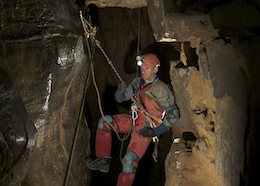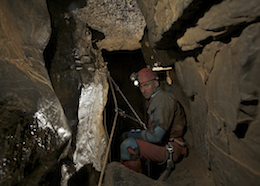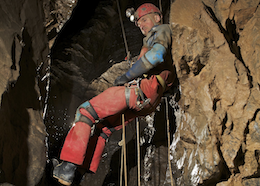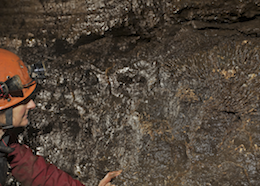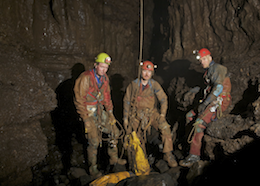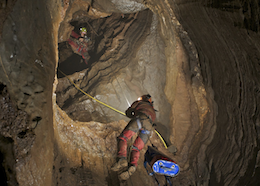Overview
Pwll Dwfn is unique in Wales as it presents itself as a pothole with a series of five pitches with very little horizontal passage development. As such this provides a very good SRT trip over it's 100m vertical range.Length 89m
Altitude 398m
Grid SN 83322 16491
History
The cave was first discovered in 1946 and documented by the South Wales Caving Club in 1947.A project to airlift silt from the terminal sump was started by Malcolm Stewart and Gareth Davies in 2011 and continues as an ongoing project.
Location
The cave is located on open hillside and is best approached from the Dan Yr Ogof carparks. (Please ask for permission to park from the showcave). The mountain track can be followed up the hill until just before Tunnel Cave Top Entrance is reached. Head west towards the exposure of limestone on the ridge and pass to the west of the limestone to drop into the dry valley. A faint footpath crosses the dry valley close to Pwll Dwfn. The cave entrance is located in a shallow dry valley and is found just uphill of a 1m x 1m large boulder. Black Mountain East Google map showing the location of Pwll Dwfn and other caves in the area.
Location map - click marker to show entrance photo
Access
No known access restrictions.
Description
The entrance is located between boulders in the valley floor and leads to a 1.5m drop over a boulder, this drops into a short section of passage leading to the top of the first pitch. The final section of the first pitch can be climbed and drops onto a boulder landing where there is fractured and loose rocks. The second pitch is accessed from the left hand side of the landing and has a tricky take-off to the Y hang at the top of the freehang. A rift at the bottom of the second pitch leads directly onto the top of the third pitch which requires the use of a short deviation partway down. Before the bottom of the pitch is reached you swing into a rift passage, the route to the fourth pitch. This rift passage is best rigged as it descends steeply to the head of the fourth pitch. The fourth pitch is the largest in the cave and requires a deviation part way down. The pitch drops onto a bouldery landing where the final 4m of the pitch continues around a corner. From the bottom of the fourth pitch the route continues down a steep bouldery slope to lead to the top of the fifth pitch. Large ledges allow you to reach the Y hang and descend well out of any water flow. At the bottom of the fifth pitch is a band of Lithostrotion coral fossils in the wall of the passage, as fine a display as is seen in any cave. From the bottom of the pitch a rift passage can be followed to reach the sump which is currently the focus of an underwater digging project. In February of 2013 on a visit to the sump to assess continuation of the sump digging project by Malcolm Stewart, Gareth Davies and Richard Frost, the rift beyound the sump was climbed and the choke at the end was also investigated. After moving some loose rocks a way could be seen through the boulders and a route was forged through. Beyond a tall rift is encountered that can be climbed for about 10m to a point where a short traverse leads into the bottom of Enterprise Aven. This has been bolted and climbed for over 60m passing a prominent ledge at 20m before starting to close down into a rift. Exploration continues at the top of the climb.
Tackle
The routes shown on the rigging topos all use the P Hangers installed. Some 8mm spits and thru bolts can be found off the described routes.Pitch 1 - 20m
Pitch 2 - 25m
Pitch 3 - 20m + 30cm deviation
Pitch 4 - 45m + 60cm deviation
Pitch 5 - 20m
References
Cambrian Cave Registry entry for Pwll DwfnAdrian Fawcett's South Wales SRT Topo Guide Including Pwll Dwfn Pot (PDF)
Adrian Fawcett's South Wales SRT Guide Home Page (MS Word)
Caves of South Wales | Tim Stratford | ISBN: 1-871890-03-9 | Published by Cordee
Selected Caves of Britain and Ireland | Des Marshall - Donald Rust | ISBN: 1-871890-43-8 | Cordee
Warnings
These is some fractured rock near the head of the second pitch.
Disclaimer
The photographs and information of this page has been provided to help cavers planning trips. Caving can be a dangerous activity, if you are interested in exploring caves please join a caving club so you can enjoy a safe introduction to this sport. Local caving clubs are listed on the links page or you can visit the 'New To Caving' website for more options.If you feel that any of the information is incorrect or should be updated please contact us.


